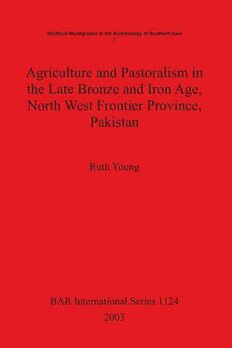
Agriculture and Pastoralism in the Late Bronze and Iron Age, North West Frontier Province, Pakistan: An integrated study of the archaeological plant and animal remains from rural and urban sites, using modern ethnographic information to develop a model of PDF
123 Pages·2003·2.07 MB·English
Most books are stored in the elastic cloud where traffic is expensive. For this reason, we have a limit on daily download.
Preview Agriculture and Pastoralism in the Late Bronze and Iron Age, North West Frontier Province, Pakistan: An integrated study of the archaeological plant and animal remains from rural and urban sites, using modern ethnographic information to develop a model of
Description:
This study compares two environmentally very different regions in The North West Frontier Province of Pakistan, during the Late Bronze and Early Iron Age, in order to better understand their contrasting subsistence strategies. The two regions under study are the valleys of Dir and Swat in the North, and the Charsadda District in the Vale of Peshawar, and these areas represent very different cultural inhabitants during this period. The study deals primarily with the period of settlement stretching from 1700-1000 BC, and this comes between the final stages of the Harappan Civilisation and the beginning of the early historic cities of Charsadda and Taxila. This is a period that has been traditionally considered one of cultural unrest, and this book looks at archaeological and environmental evidence from both old and new sources in order to gain a better perspective on this apparent period of discontinuity in these two regions. Particular attention is paid to the analysis of plant and animal remains in order to understand the development of subsistence strategies over time. Ethnographic studies were also carried out in order to gain a model of subsistence land use in these areas, and these are compared to the archaeological evidence, some of which is new, some of which is a re-examination of previous studies. This allows conclusions to be formed over how important certain factors are on subsistence strategies in the regions in question, contrasting between geographical and environmental situations on one side, and other factors such as culture, race and religious beliefs.
See more
The list of books you might like
Most books are stored in the elastic cloud where traffic is expensive. For this reason, we have a limit on daily download.
